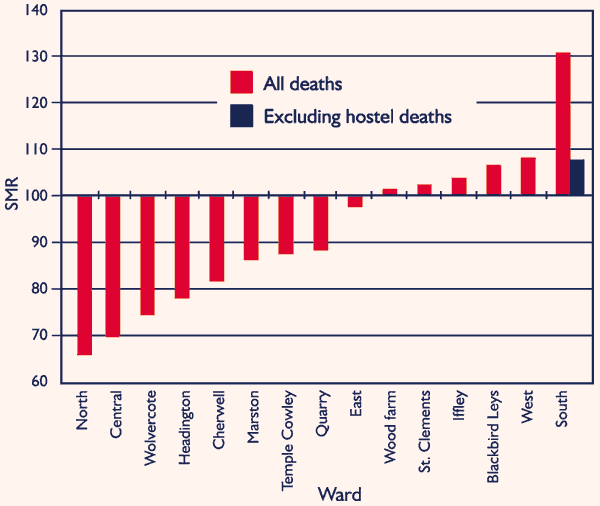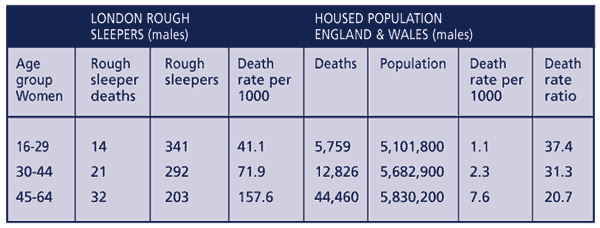 |
Close
window to return
|
Issue 2, July 1998, pp.8-9.
Explaining
geographical inequalities in health
Mary Shaw, Danny Dorling and Nichola Brimblecombe
The social and
spatial polarisation of life chances
There have been dramatic reductions in death rates in Britain over the
past century, with an accompanying rise in life expectancy. However, this
gain has not been equally distributed throughout the population. Not only
are there persisting differences in mortality between social classes,
but the gap has been widening. For example, for men, the difference in
life expectancy between those in social classes I and II and those in
classes IV and V is now over 5 years, and for women this gap is over 3
years.
Alongside this social polarisation of life chances, there has been a spatial
polarisation of life chances. Regional inequalities in mortality have
been reported since data were first available in the last century. It
is consistently found that mortality rates are highest in the north and
in Scotland and lower in the south: Britain can effectively be divided
into two zones of high and low mortality. As well as these regional differences
in mortality, there are differences between places at smaller geographical
levels: at local government district and, particularly, at electoral ward
level. Moreover, these differences between places are becoming greater.
In the most recent period for which data are available (1990-92), the
ten percent of the population living in areas of Britain with the highest
death rates have the worst ever recorded relative mortality rates for
a single set of districts in Britain, with a standardised mortality rate
(SMR) of 142.3 for people aged under 65. Since 1981, the SMR of this group
has increased by 7.4 percentage points.
Housing
wealth and community health
The social polarisation which has occurred in Britain over the past two
decades - the well-documented increasing gap between the rich and the
poor - can only partially account for this spatial polarisation. The 'Housing
wealth and community health' project is investigating, on various geographical
levels, the role played by migration and other factors in producing this
polarisation.
One of the aims of the project is to pay particular attention to the possible
role of changes in the housing market in the polarisation of health. Changes
in access to owner-occupied and local authority accommodation may have
contributed to the spatial polarisation of mortality in the 1980s. This
was a decade in which the supply of council housing declined sharply,
with the result that medical factors may have become a more important
criterion for the allocation of council housing. Poor health may also
have acted as a barrier to owner-occupation. As housing choices become
more dependent on both health and wealth, it is possible that poorer people
in worse health are more likely than before to move to ( or not leave)
already high-mortality areas and regions, while richer people in better
health move to lower-mortality areas and regions. Such a process would
contribute to the geographical polarisation of health. We are currently
collecting evidence to support this hypothesis, by using a variety of
different sources of secondary data (ONS mortality data, Census data,
Building Society wealth data, the British Household Panel Survey and the
Longitudinal Study) as well as local case studies.
High mortality rates among the homeless and vulnerably housed
Our local case studies focus on Brighton and Oxford. These studies have
suggested that pockets of high mortality in areas which are relatively
affluent and which have close to the national rate of mortality might
be largely explained by one of the outcomes of the changes to the housing
market in the 1980s and 1990s: increasing homelessness. In Brighton, for
instance, the electoral wards with the highest mortality are those with
relatively large numbers of people sleeping rough and with many people
who are vulnerably housed, a group that includes those living in temporary
bed and breakfast accommodation, in poor quality (but expensive) bedsits
or in hostels for the homeless. In Oxford, if the deaths of those men
whose residence at time of death was recorded as a hostel for the homeless
are taken into account, then the distribution of elevated ward mortality
is dramatically reduced (see Figure 1).
Figure 1: SMRs for men by ward with and without hostel deaths

Analysis of data collected by the charity Crisis on deaths of homeless
men in London which were recorded as 'No Fixed Abode' also suggest that
rough sleepers have significantly elevated mortality rates compared to
the general population. Table 1 compares the death rates for these two
groups. The standardised mortality ratio for male rough sleepers for the
age group 16-64 is 2587.
The death rate for male rough sleepers aged 16 to 64 is 26 times higher than the death rate for the general population.
Table 1: SMRs for male rough sleepers in London

Moreover, in both
Brighton and Oxford, there is evidence that the homeless and vulnerably
housed are more likely than other people to have migrated from other areas.
This suggests that the differential migration of those who are most socially
excluded, in combination with various locally-specific cultural, social
and economic factors, produces a spatial polarisation of mortality. Similarly,
our initial analysis of the British Household Panel Survey (BHPS) has
found that the lifetime selective migration of the affluent also tends
to move them towards areas that subsequently experience much lower rates
of mortality. Our current research is considering the extent to which
the geographical concentration of the vulnerably housed in particular
wards across Britain explains part of the polarisation on a national scale.
We are also examining the extent to which lifetime migration in general
produces the geography of mortality seen across Britain today.